BONSAI MAKING
Bonsai is an art of growing and training of a plant to a miniature form having a natural look of old age. It was originated from china, but it was called as the Japanese art. It involves techniques of extreme dwarfing. The optimum size of bonsai may be only 30 to 60 cm in height, but miniature sizes of below 25 cm have also been preferred. Bonsai of minimum 10 years old are period, but of 100 and even 200 years of age are available and are highly valued as ‘venerable’ specimens.
Bonsai requires special types of containers. They should be usually shallow with 5 to 7.5 cm deep (except for cascade type of bonsai for which deep pots can be used). Round, hexagonal or square shaped containers with 25 to 30 cm diameters are preferred. Containers with specific colours like mosaic, sky blue, terra cotta, grey or jungle green are well suited for bonsai culture. Plants adaptable for extreme dwarfing like juniper. pine, elm, maple, cypress are suitable materials for bonsai culture. But in tropical places like India, the tree species like Manilkhara, Sapota, Bassia, Tamarind and Ficus spp. and shrubs like West Indian cherry are well suited.
Trunk and branches may be bent, forced and tied by coiling them with heavy wire. This wire is removed after several months when training to shape has been accomplished. The bonsai plants may be trained to different shapes like twisted trunk, upright, S-shaped, semi-cascade, cascade, slanting or any other formal shape. Planting of both tips and roots is usually done at planting time and periodically pinching the tip and removing the excess side shoots are essential to maintain the general outline of design. Annually, the plants are either repotted or lifted from the pot, root pruned and reset.
The bonsai plant is fed sparingly of week fertilizer solution containing major and minor nutrients. Sometimes extracts of oil cakes may be also added. Similarly, the plant is given only minimum requirements of moisture. It is advisable to water twice a day to plants kept in shallow containers and once a day to plants kept in deeper pots.
Selection of hardened woody plants that have been subjected to adverse conditions is a good starting point. Such kind of planting materials may be collected from rock crevices of from the walls of any buildings. Old seedlings kept in containers form any nursery or cutting, grafted plants or layers may be also utilized in bonsai culture.
Where it succeeds?
- Under open sunny conditions
- Under air conditions
- As indoor near windows only.
Rules for Bonsai making
For trunk
- Height can be 6 times the caliper of the trunk.
- Should lean towards the viewer.
- It should anchor the plant.
- Roots should radiate.
- No eye poking roots.
- Should taper as it ascends
- Should not move back
For Branches
- Should not cross the trunk
- No eye poking branches
- First branch should be at one third height of the tree
- No belly branches
- Should be opposite
- Should diminish in size as it ascends
- Secondary branches are to be alternate
Principles of Bonsai
Look for
- Small leaves or needles
- Shorter internodes
- Attractive bark or roots
- Branching characteristics
To enhance the age, expose the one third of the roots
- Before potting, the twisted and tangled roots are to be straightened.
- Upper branches should not overshadow the lower branches.
Plants suitable for Bonsai making
1. Ficus benjamina
2. Ficus Carmona microphylla
3. Ficus nerifolia
4. Ficus retusa
5. Ficus virens
6. Ficus pelkan
7. Ficus parasitica
8. Ficus krishna
9. Ficus elastica
10. Ficus trangularis variegated
11. Ficus mysorensis
12. Ficus nooda Variegated
13. Ficus tomentosa
14. Ficus saliscifolia
15. Ficus jaquinifolia
16. Ficus long Island
17. Ficus marginata
18. Ficus lipstick
19. Bougainvillea
20. Bottle Brush - Red / White / Lavender
21. Black Olive
22. Brazilian Raintree
23. Cashew
24. Casuarinas
25. Chinese Banyan
26. Chinese Mini Orange
27. Duranta Gold
28. Duranta Variegated
29. Golden Cypress
30. Hamelia patens
31. Hibiscus rosea sinensis
32. Inga Dulse Variegated
33. Jackaranda
34. Jasmine Kamini
35. Juniper chinensis
36. Karonda
37. Lavender Brown
38. Lavender Green
39. Badam
40. Mango
41. Murraya exotica
42. Murraya paniculata
43. Neem
44. Pine
45. Pomegranate Mini
46. Powder Puff - White / Pink / Red (Calliandra)
47. Poinsettia Mini
48. Kumquat
49. Sapota
50. Scheffleura Variegated
51. Silver Oak
52. Surinam Cherry
53. Tamarind
54. Wood apple
55. West Indian Cherry
56. Wrightia religiosa
Styles of bonsai
Formal Upright
It is one of the most natural styles where the trunk is perfectly straight. The branches should alternate left to right to suggest age. The bottom third branches are removed and the remainder is drawn downward.
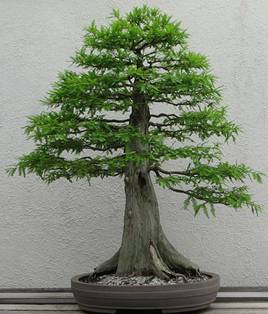
|
Formal upright style |
Informal Upright
This style is characterized by a lightly curving trunk displaying the harsh elements of nature. This can be achieved with ease using wire and/or cords. It is as appropriate for conifers as with deciduous trees.
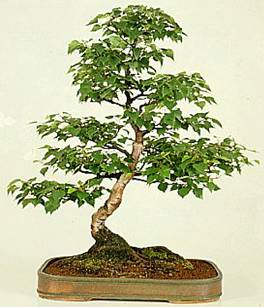
|
Informal upright style |
Broom
It has a straight trunk that begins to divide and subdivide into many branches. The characteristics are its thick and finely branched crown. Some trees for this style are Beech, Elm, False cypress and Maple.
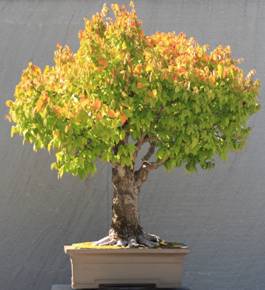
|
Broom style |
Slanting
It is so called because the general slope of the trunk is highly pronounced. The branches should lie horizontal or droop slightly downward. The surface roots have an unstable appearance but have a well anchored impression.
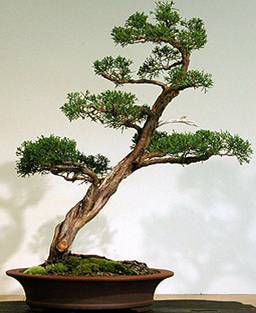
|
Slanting style |
Windblown
It is rare in nature. This kind of tree is found on cliffs or mountains. The trunk, branches and twigs are trained in a single direction to give the affect of a strong wind and storm.

|
Windblown style |
The Clasped-to-Stone
It is a much loved but difficult to create style. The size and shape of the rock should complement the plant that is set on a gravel or water dish. A whole chapter could be spend on this style.
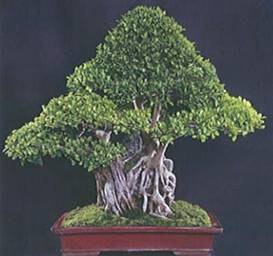
|
Clasped-to-stone style |
Agrotechniques for Bonsai
1. Propagation
2. Season
3. Potting and repotting
4. After care
5. Container
6. Planting media
Propagation
Through seeds, cuttings, layering or grafting
Seeds: Pines and Junifers
Cuttings: Ficus, Pomegranate, Mulberry and Bougainvilleas
Layers: Jasmine, Ixora, Bougainvilleas and Pome granate
Grafts: Mango, Sapota, Citrus
Season
1 July - August
2. Febraury - March
Best time is before opening of the buds
Potting and repotting
- 1/3 of the roots can be trimmed
- Long tap roots are to trimmed
- Excessive branches are to thinned out
- Balanced nutrition and adequate watering is must
- Potting is not advisable during winter or hot months
- Repotting is done after 2-3 years
After care
Pinching - Once or twice
Pruning - For its shape
Training - Desirable shape
It is achieved through copper wire or polythene tape. It is to be removed once the shape is attained.
Containers
- Mostly terracotta or ceramic
- Small in size
- Square/round/rectangle/oval in shape
- Preferred is oval / rectangle
In round / square the plant is to be in the centre
In others placed in the sides of the containers.
Planting Media
Media consists of
Loam soil 2 parts
Leaf mould 1 parts
Coarse sand little
Media can be covered with moss and one or two pebbles can be placed to give a natural look.
Source
1. http://www.bonsai-tree-books.com/wp-content/themes/bible-scholar/images/formal_upright1.jpg
2. http://www.dkimages.com/discover/previews/817/25103526.JPG
3. http://www.bonsai-tree-books.com/wp-content/themes/bible-scholar/images/broom_style1.jpg
4. http://www.bonsai-nbf.org/site/images/3_local/jack-4.jpg
5. http://dragongardennursery.com/images/Gallery/gallery021B.jpg |






